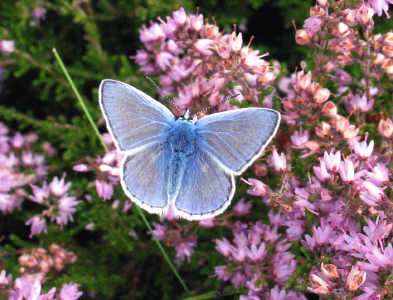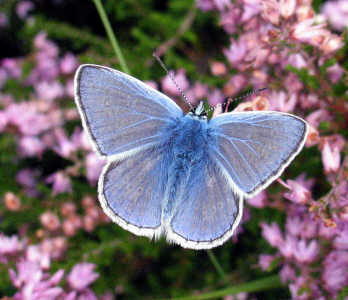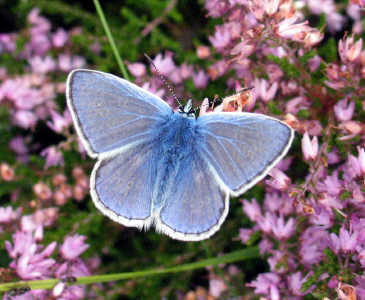Common Blue (Polyommatus iccarus )
Identification
Wingspan, 30m-35 mm.Males are coloured a bright blue on the upper surfaces of both sets of wings which are narrowly bordered black, inside a white marginal fringe. The under surfaces of the wings have a brown ground colouration with a row of orange spots towards their margins with the inner areas covered with numerous, white-edged, black spots. There is often a blue or even green flush at the base of the wings on their undersufaces.
Female upper-wings are distinguished from those of the male by having a row of orange spots around the outside of both the fore and hind-wings. The upper-wings are very variable in base colour and may be almost completely blue to almost completely dark brown with only a blue flush at their bases.






The Common Blue is the most widespread blue butterfly in Britain and Ireland and is found in a variety of grassy habitats.
The brightly coloured males are conspicuous but females are more secretive. The colour of the upperwings of females varies from almost completely brown in southern England to predominantly blue in western Ireland and Scotland, but the colour is variable within local populations with some striking examples.
It remains widespread but there have been local declines within its range.
Behaviour and life history
The Common Blue is a colonial species centred on sites where there are good populations of their larval food plants, principally Birds-foot Trefoil, Lotus corniculatus. The butterflies generally spend their time flying low over their breeding area, resting up on and feeding off flower heads. Males will wander from their colonies and single males can be seen almost anywhere. The caterpillar over-winters deep inside tussocks of grass and completes its development the following spring. It pupates at the end of April or early May on the ground and its chrysalis is buried underground by ants attracted to it by its sugary secretions. The first brood adults emerge in late May and lay their eggs. Its life cycle is completed by late July or early August when the first of the second brood adults appear. In good years a third brood can occur during late September and August. Birds-foot Trefoil, Lotus corniculatus, and the Marsh Birds-foot Trefoil, Lotus uliginosus, are the main larval food plants although Restharrow, Ononis repens, and Black Meddick, Medicago lupulina, are also favoured.
Where to look for it
Any site where the larval food plants are to be found. These range from short, non-intensively managed grasslands to sites with poor, shallow soils such as quarries, old railway lines and wasteland. Not uncommonly, it visits urban gardens.
Distribution and status
When to look for it
Adults are on the wing between mid May to late October with numbers peaking in June, August and early September.
Similar species
Easily confused with the Holly Blue, Celastrina argiolus, but the orange spots on the underside of the wings, the presence of orange spots on the upper surfaces of the wings in the female and the wholly white fringe of the forewings in both sexes distinguish it from the this species. Additionally, the Common Blue, unlike the Holly Blue, typically tends to hug the ground in flight.

